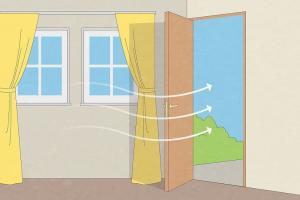Effective Strategies to Improve Air Circulation in Stuffy Rooms

-
Quick Links:
- Understanding Air Circulation
- Symptoms of Stuffy Rooms
- Causes of Stuffy Rooms
- Importance of Air Circulation
- Simple Ways to Get Air Moving
- Advanced Techniques for Air Movement
- Case Studies
- Expert Insights
- FAQs
Understanding Air Circulation
Air circulation is the movement of air within a given space. It is essential for maintaining a comfortable and healthy environment, particularly in closed or stuffy rooms. Proper air circulation helps to regulate temperature, remove pollutants, and enhance overall indoor air quality.
Symptoms of Stuffy Rooms
Recognizing a stuffy room is the first step in addressing air circulation issues. Symptoms include:
- Increased humidity levels
- Unpleasant odors
- Visible mold or mildew
- Excessive heat or cold
- Feeling fatigued or drowsy
- Allergic reactions or respiratory issues
Causes of Stuffy Rooms
The buildup of stale air and lack of ventilation are primary causes of stuffy rooms. Common contributors include:
- Sealed windows and doors
- Insufficient air exchanges
- High levels of humidity
- Heating systems that lack fresh air intake
- Blocked vents or ducts
Importance of Air Circulation
Good air circulation is vital for several reasons:
- Enhances comfort levels
- Reduces humidity and prevents mold growth
- Improves indoor air quality
- Increases energy efficiency in heating and cooling systems
- Promotes better health and well-being
Simple Ways to Get Air Moving
1. Open Windows and Doors
Opening windows and doors is the simplest method to introduce fresh air into a closed space. Cross-ventilation can be achieved by opening windows on opposite sides of the room.
2. Use Fans
Fans are effective tools for enhancing air circulation. Here are some tips:
- Position fans near windows to draw in fresh air.
- Use ceiling fans to create a downdraft.
- Place box fans in doorways to push stale air out.
3. Create a Cross Breeze
To create a cross breeze, open two windows on opposite sides of the room and use fans to guide the airflow. This method is particularly effective in the evening when outdoor temperatures drop.
4. Utilize Exhaust Fans
Exhaust fans in kitchens and bathrooms help remove stale air and moisture. Ensure these fans are functioning correctly and use them regularly.
5. Incorporate Air Purifiers
Air purifiers not only filter pollutants but also circulate air within a room. Look for models with a HEPA filter for optimal performance.
Advanced Techniques for Air Movement
1. Install Ventilation Systems
For long-term solutions, consider installing a mechanical ventilation system that ensures a continuous flow of fresh air.
2. Use HVAC Systems Wisely
Ensure your HVAC system is well-maintained. Regularly replace filters and check ducts for blockages to maximize airflow.
3. Implement Passive Ventilation
Passive ventilation techniques such as skylights and ventilation chimneys can naturally improve airflow without mechanical assistance.
4. Landscape for Airflow
Landscaping can influence airflow around your home. Strategically placed trees and shrubs can create windbreaks while allowing air to circulate freely.
Case Studies
Let’s explore a few real-world examples where air circulation improvements made a significant difference:
Case Study 1: Residential Home in Florida
A family in Florida struggled with high humidity and poor air quality. After installing a whole-house ventilation system, they experienced a 40% decrease in humidity levels, leading to improved comfort and health.
Case Study 2: Office Building in New York City
In a New York office building, employees reported fatigue and discomfort. By implementing a series of exhaust fans and improving the HVAC system, employee satisfaction increased by 30% within two months.
Expert Insights
We consulted with HVAC experts and indoor air quality specialists to gather insights on maintaining effective air circulation:
"Regular maintenance of HVAC systems and the use of exhaust fans can dramatically improve indoor air quality and comfort levels." - Dr. Jane Smith, Indoor Air Quality Expert
FAQs
1. What are the signs of poor air circulation?
Signs include stale odors, increased humidity, and allergens in the air.
2. How can I improve air quality in my home?
Consider using air purifiers, maintaining HVAC systems, and ensuring proper ventilation.
3. Are ceiling fans effective for air circulation?
Yes, ceiling fans help to distribute air evenly and can create a cooling effect.
4. What is the best way to ventilate a small room?
Open windows, use fans, and consider an air purifier for optimal ventilation.
5. How often should I change my HVAC filters?
Filters should typically be changed every 3 months, but check manufacturer's recommendations.
6. Can indoor plants help with air circulation?
Yes, certain indoor plants can improve air quality and contribute to a healthier environment.
7. Is it safe to leave windows open at night?
Yes, as long as outdoor air is clean, it can help ventilate your space.
8. How can I create natural ventilation?
Open windows, use vents, and design your home to maximize airflow through layout and landscaping.
9. What role does humidity play in air circulation?
High humidity can make air feel stuffy and uncomfortable. Managing humidity levels helps improve circulation.
10. Should I use exhaust fans continuously?
Not necessarily; use them during peak humidity times or when cooking to remove stale air effectively.